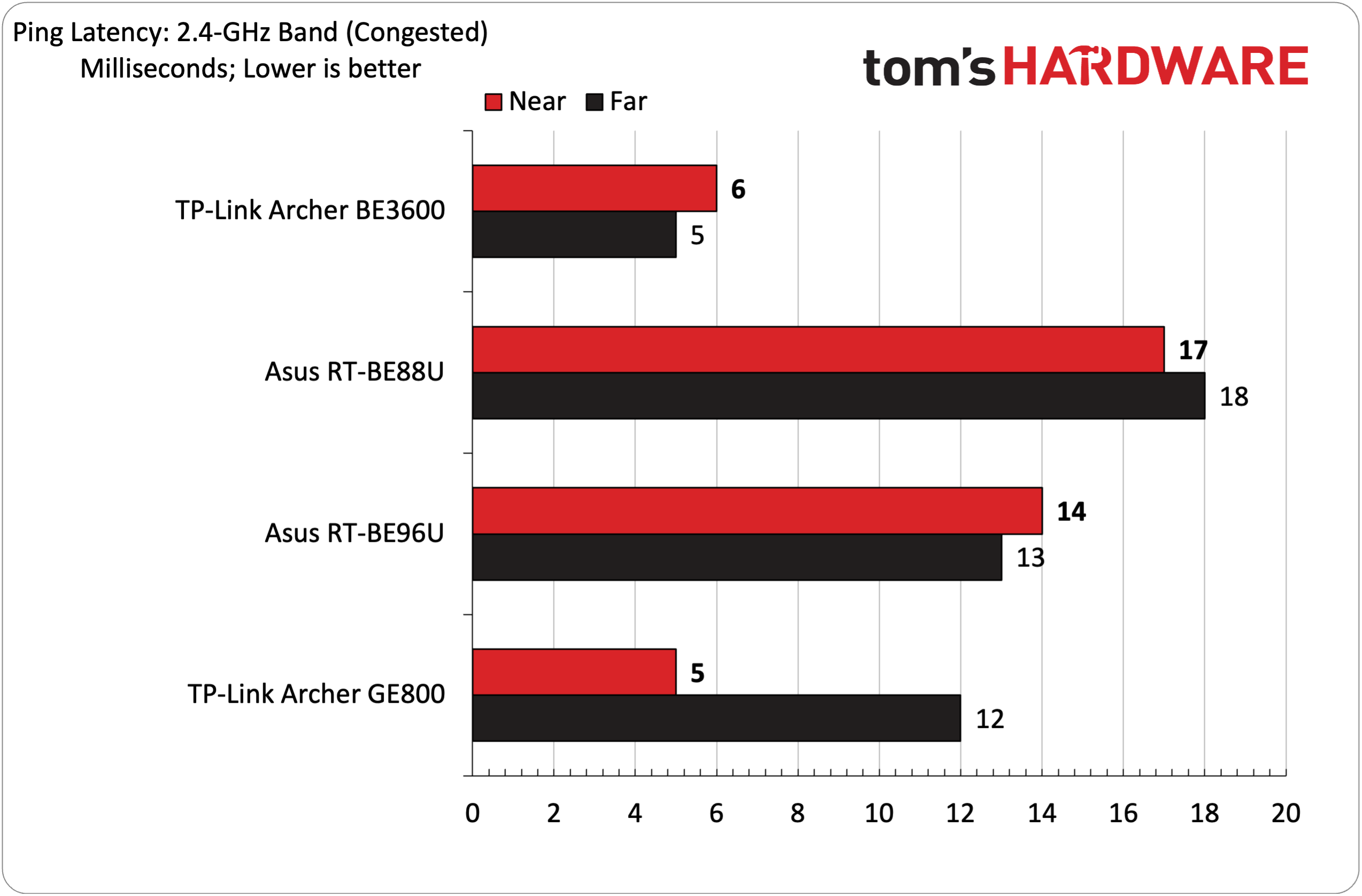Tom's Hardware Verdict
The TP-Link Archer BE3600 is cheap, but you also don’t get the full spec of features or performance of “true” Wi-Fi 7 routers
Pros
- +
Sub-$100 price tag
- +
Strong 2.4 GHz and 5 GHz performance at close range
- +
Two 2.5 Gbps ports
Cons
- -
Lacks 6 GHz band
- -
Performance at 25 feet was lacking
Why you can trust Tom's Hardware
Wi-Fi 7 is still a nascent player in the market for the best Wi-Fi routers. Wi-Fi 7 client devices pale in comparison to Wi-Fi 6E and Wi-Fi 6 counterparts, and Wi-Fi 7 routers can cost hundreds of dollars, with high-end mesh systems easily surpassing the $1,000 barrier. Some router manufacturers are combating the pricing issue by taking the unorthodox approach of excluding one of the key pillars of the Wi-Fi 7 standard, like the 6 GHz band, to appeal to more value-conscious buyers.
We first saw this with the Asus RT-BE88U, which carries an MSRP of $349.99. However, TP-Link’s new Archer BE3600 takes the price cuts even further, thanks to an MSRP of $99 as a Walmart-exclusive. The Archer BE3600 represents a bargain in the Wi-Fi 7 router market, although we still question how wise it is to market these feature-crippled products with the Wi-Fi 7 label.
Design of the TP-Link Archer BE3600 Wi-Fi 7 Router
The Archer BE3600 flies under the radar with its no-nonsense design. It has a flat, rectangular shape reminiscent of older Wi-Fi 5 and Wi-Fi 6 routers. The outer edges of the router have a shiny black finish, while the top cover is a flat black mesh. A grouping of seven white status LEDs are positioned on the top of the router.
The Archer BE3600 has four antennas, which are clustered around the rear corners of the router. Perhaps in keeping with the bargain basement pricing of the Archer BE3600, you can actually see the wires leading from the router to its antennas. This “behind the scenes” aspect of modern wireless routers are usually hidden, but TP-Link didn’t bother with such discreetness with the Archer BE3600.
The bottom of the router has more ventilation for the onboard hardware, along with two cutouts to mount the Archer BE3600 onto a wall.



The “business end” of the Archer BE3600 features one 2.5 Gbps port for WAN and one 2.5 Gbps port for LAN. There are three 1 Gbps LAN ports to round out the wired networking portfolio. In addition, there’s a single USB 3.0 port for connecting a printer or storage device. You also find a power button and three buttons dedicated to turning on/off the front LEDs, enabling Wi-Fi Protected Setup (WPS), and turning off Wi-Fi. There’s also a pinhole button for resetting the router’s settings.
I’d also like to point out that this is a 2 x 2 Wi-Fi 7 router, which limits its maximum wireless performance. For comparison, the Asus RT-BE88U is a 4 x 4 Wi-Fi 7 router, capable of data rates up to 1,376 Mbps on the 2.4 GHz band and 5,764 Mbps on the 5 GHz band. The Archer BE3600’s maximum theoretical data rates are exactly half that of the RT-BE88U. Maximum bandwidth for the Archer BE3600 is 3,570 Mbps (688 Mbps + 2,882 Mbps).
Get Tom's Hardware's best news and in-depth reviews, straight to your inbox.
TP-Link Archer BE3600 Wi-Fi 7 Router Specifications
| Wi-Fi Standard | Wi-Fi 7 |
| Wi-Fi Bands | 2.4-GHz: 2x2 (Tx/Rx) up to 688 Mbps |
| Row 2 - Cell 0 | 5-GHz: 2x2 (Tx/Rx) up to 2,882 Mbps |
| CPU | Not disclosed |
| Memory | Not disclosed |
| Ports | 1 x 2.5 Gbps for WAN, 1 x 2.5 Gbps for LAN, 3 x 1 Gbps for LAN, USB 3.0 |
Setting up the TP-Link Archer BE3600 Wi-Fi 7 Router
The Archer BE3600 was a breeze to set up. After powering on the router, I pointed my browser to tplinkwifi.net, which started the configuration process. I was first asked to choose a new administrator password and then was presented with options to configure the Wi-Fi radios. These options included Smart Connect (using one SSID for 2.4 GHz and 5 GHz bands), giving each band its own SSID, and setting up guest networks for the 2.4 GHz and 5 GHz bands.
The final step in the relatively quick setup process was to update the firmware — a new firmware update was discovered and applied automatically. Our review unit was updated to firmware 1.1.0 Build 20240729.
TP-Link Archer BE3600 Wi-Fi 7 Router Software
The software interface for the Archer BE3600 is similar to what we saw with the more powerful (and full-featured) Archer GE800 tri-band Wi-Fi 7 router. There are five primary tabs at the top of the homepage: Network Map, Internet, Wireless, HomeShield, and Advanced. It's lacking the Game Center tab from the Archer GE800 for obvious reasons. One other change of note is that by default, the Archer BE3600 has a lighter, more cheerful turquoise and white color scheme for the user interface. The Archer GE800, on the other hand, features a more menacing navy blue and black interface.








Network Map displays an overview of your network, including internet connection status, IP address, router uptime, the number of mesh devices on the network and the number of connected clients. Internet displays your current internet connection type and allows you to clone the MAC address of the router. Wireless gives you complete control over the 2.4 GHz and 5 GHz bands and lets you create an MLO network to combine the two bands for improved performance. You can also create guest or IoT networks on either band.
HomeShield will scan your network for security vulnerabilities and provides access to basic parental controls. Finally, the Advanced tab gives you granular control over common router functions/features. This is where you'll find controls for Amazon Alexa and Google Assistant integration, and USB storage (like one of the best USB flash drives or the best external SSDs). Like the Archer GE800, the Archer BE3600 also has support out-of-the-box for Time Machine backups on Macs.
TP-Link Archer BE3600 Wi-Fi 7 Router Performance
The Archer BE3600 is the second router we’ve tested that uses our new purpose-built rig. We are using a new test rig for Wi-Fi testing with a purpose-built rig (the first was the Archer GE800). The rig uses an MSI Pro B650M-A Wi-Fi motherboard, AMD Ryzen 5 7600 processor, 32GB of DDR5 memory, a 1TB PCIe 4.0 SSD, an MSI Herald-BE Wi-Fi 7 adapter (Qualcomm NCM865 chipset), and Windows 11 Home.








Our iPerf3 and ping tests are conducted at distances of six feet and 25 feet, with and without traffic on the network. In the congested traffic tests, we add six wireless clients streaming 4K YouTube videos across all bands.
The first thing I noticed from the iPerf3 tests was that performance on the 2.4 GHz band at six feet was surprisingly strong. I kept rerunning the tests to verify the performance, but the Archer BE3600 managed 214 Mbps at six feet with no traffic and 205 Mbps when congested. Both figures put the router well ahead of the competition, even the pricier Archer GE800 and Asus RT-BE96U. However, performance at 25 feet took a dramatic turn, falling to just 51 Mbps and 45 Mbps, respectively, putting it in last place.
It was a similar story with the 5 GHz tests, with the Archer 3600 putting up a respectable 1,121 Mbps with no traffic and 1,030 Mbps when congested. However, iPerf3 performance fell to just 382 Mbps (uncongested) and 374 Mbps (congested) at 25 feet.
Bottom Line
At times, it can be difficult to wrap your head around the premise of the TP-Link Archer BE3600. It’s labeled as a Wi-Fi 7 router, but it doesn’t support the full Wi-Fi 7 spec — namely, it’s missing the 6 GHz band, and performance suffers as a result. In addition, since this is a 2 x 2 Wi-Fi router, it offers half the theoretical performance of other dual-band Wi-Fi 7 peers like the Asus RT-BE88U.
However, the performance turned out to be a mixed bag. The Archer BE3600 turned in excellent numbers on the 2.4 GHz band at close range, bettering even the more expensive competition. However, performance fell well behind at 25 feet. The 5 GHz band also showed a Dr. Jekyll and Mr. Hyde personality, with competitive performance at 6 feet but underperforming at 25 feet.
Despite the uneven performance, it’s hard not to be drawn in by the $99 price tag, especially when considering the Asus RT-BE88U retails for over three times the price (although that pricier offering does include 10 Gbps ports). My biggest issue is with routers like the Archer BE3600 being labeled as Wi-Fi 7. Many consumers are likely to be lulled in by the low price tag and not realize that they aren’t getting the complete Wi-Fi 7 experience with these dual-band routers.
If you’re not big into gaming and just want a no-frills router to support your 1 Gbps or lower internet connection, there’s nothing wrong with the Archer BE3600. Just realize that you’re leaving a lot of performance on the table compared to full-featured Wi-Fi 7 routers. And if you want an added performance without breaking the bank, consider looking at budget Wi-Fi 6E routers.

Brandon Hill is a senior editor at Tom's Hardware. He has written about PC and Mac tech since the late 1990s with bylines at AnandTech, DailyTech, and Hot Hardware. When he is not consuming copious amounts of tech news, he can be found enjoying the NC mountains or the beach with his wife and two sons.
-
BadBoyGreek IMO, wireless is only ever good for mobile devices these days, i.e. tablets, mobile phones and the like. And while performance over wifi might be “good enough” for the majority of people, it will never compare to wired connections, no matter how many improvements there are in the wireless spec.Reply
It’s not so bad inside of houses, but in apartments and condos, wireless tends to be flaky at best, especially when signals have to pass through concrete walls. To be fair, I haven’t tested Wifi 7 to say for sure, but I imagine it has many of the same challenges. Does the 6 GHz band offer an improved ability to pass signal through concrete walls?
In any event, when it comes to my main PC, work laptop and servers at home, I will continue to stick with wired connections. -
Kondamin Reply
Nope short distance low power high bandwidth.BadBoyGreek said:IMO, wireless is only ever good for mobile devices these days, i.e. tablets, mobile phones and the like. And while performance over wifi might be “good enough” for the majority of people, it will never compare to wired connections, no matter how many improvements there are in the wireless spec.
It’s not so bad inside of houses, but in apartments and condos, wireless tends to be flaky at best, especially when signals have to pass through concrete walls. To be fair, I haven’t tested Wifi 7 to say for sure, but I imagine it has many of the same challenges. Does the 6 GHz band offer an improved ability to pass signal through concrete walls?
In any event, when it comes to my main PC, work laptop and servers at home, I will continue to stick with wired connections.
AP in every room kind of thing -
BadBoyGreek Reply
Figured as much. My network has been hybrid 2.5/10G for a while now with an 8 GB FTTH internet connection and all my computers, TVs, gaming consoles and servers are all hard-wired. I only use the wifi for streaming on phones, tablets and for my security system. Wifi 7 APs / routers are still too expensive to consider upgrading to at this point.Kondamin said:Nope short distance low power high bandwidth.
AP in every room kind of thing